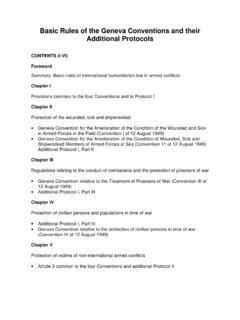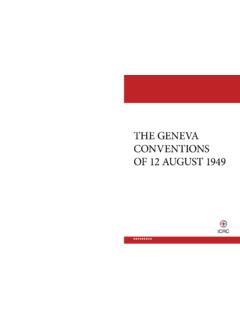Transcription of Framework of Analysis
1 Framework of Analysisfor ATROCITY CRImESA tool for preventionUnited Nations[blank inside cover] Framework of Analysisfor ATROCITY CRIMESA tool for preventionUnited Nations, 2014 Cover photos (counter-clockwise from top):Santa Cruz massacre 17th anniversary march, Dili, UN Photo/Martine PerretA woman testifies in the trial of former Guatemalan military dictator, Photo Elena Hermosa/Trocaire, licensed under Creative Commons Attribution Generic licenseA woman mourns at the Srebrenica-Potocari memorial and cemetery, AP Photo/Marko DrobnjakovicDarfur village abandoned after heavy clashes, UN Photo/Albert Gonz lez FarranRwandan refugees returning from Goma, UN Photo/John IsaacYoung children at the Killing Fields memorial in the outskirts of Phnom Penh, UN Photo/John IsaacSecretary-General Ban visits Auschwitz-Birkenau.
2 Poland UN Photo/Evan SchneideriiiiiiFramework of Analysis for Atrocity CrimesA tool for preventionForeword by the Secretary-General of the United NationsAll of us have a responsibility to ask ourselves what we can do to protect populations from the most serious international crimes: genocide, crimes against human-ity and war crimes. These crimes continue to be per-petrated in many places across the world. Although calls for accountability are now the norm when such crimes are committed, impunity is all too common. We can and must do more, much earlier, to save lives and prevent societies from collapsing and descending into horrific violence. The first thing we can do is to be more alert and pay attention to the warning signs. Atrocity crimes take place on a large scale, and are not spontaneous or isolated events; they are processes, with histories, precursors and triggering factors which, combined, enable their commission.
3 My Special Advisers on the Prevention of Genocide and on the Responsibility to Protect have developed this Framework of Analysis for the Prevention of Atrocity Crimes as a guide for assessing the risk of genocide, crimes against humanity and war crimes. With the help of the Framework , we can better sound the alarm, promote action, improve monitoring or early warning by different actors, and help Member States to identify gaps in their atrocity prevention capacities and am pleased to present this Framework at a time when the United Nations is undergoing a system-wide revision of the way we respond to situations where serious violations of international human rights and humanitarian law are happening or could happen. Through the Human Rights Up Front initiative, we are committed to upholding the promise of never again and drawing lessons from past failures.
4 In practice, it means putting human rights, the protection of popu-lations and the prevention of atrocity crimes at the centre of our work. As affirmed at the 2005 World Summit, States have the primary responsibility for protecting their own populations from genocide, war crimes, ethnic cleans-ing and crimes against humanity. The international community has committed to support each State in this endeavour and, should States manifestly fail in meeting their responsibilities, to take collective action in a timely and decisive manner in line with the United Nations Charter. I therefore urge the widest possible use of this Framework to support prevention strategies at the national, regional and international levels. Prevention means acting early; to do that, we need to know what to look for.
5 Together with a commitment to account-ability, we owe this to the millions of victims of the horrific international crimes of the past and those whose lives we may be able to save in the Ki-moon United Nations Secretary-General July 2014A tool for preventionvFramework of Analysis for Atrocity CrimesContentsForeword by the Secretary-General of the United Nations ..iiiI. INTRODUCING THE Framework OF Analysis ..1 What do we mean by atrocity crimes? ..1 Who are the victims of atrocity crimes? ..1 Why is it important to prevent atrocity crimes? ..2Is there a legal responsibility to prevent atrocity crimes? ..2 How can atrocity crimes be prevented?..3 What are the roles of the Special Advisers on the Prevention of Genocide and on the Responsibility to Protect? ..4 What is the Framework of Analysis ?
6 5 What are risk factors and indicators? ..5 How to use the Framework of Analysis ..6 How accurate are risk assessments of atrocity crimes? ..7II. Framework OF Analysis FOR ATROCITY CRIMES ..9 Common Risk FactorsRisk Factor 1: Situations of armed conflict or other forms of instability ..10 Risk Factor 2: Record of serious violations of international human rights and humanitarian law ..11 Risk Factor 3: Weakness of State structures ..12 Risk Factor 4: Motives or incentives ..13 Risk Factor 5: Capacity to commit atrocity crimes ..14 Risk Factor 6: Absence of mitigating factors ..15 Risk Factor 7: Enabling circumstances or preparatory action ..16 Risk Factor 8: Triggering factors ..17 Specific Risk FactorsRisk Factor 9: Intergroup tensions or patterns of discrimination against protected groups ..18 Risk Factor 10: Signs of an intent to destroy in whole or in part a protected group.
7 19 Risk Factor 11: Signs of a widespread or systematic attack against any civilian population ..20 Risk Factor 12: Signs of a plan or policy to attack any civilian population ..21 Risk Factor 13: Serious threats to those protected under international humanitarian law ..22 Risk Factor 14: Serious threats to humanitarian or peacekeeping operations ..24 ANNEX I: Legal Definitions of Atrocity Crimes ..25 Atrocity crimes are considered to be the most serious crimes against humankind. Their status as international crimes is based on the belief that the acts associated with them affect the core dignity of human INTRODUCING THE Framework OF ANALYSISWhat do we mean by atrocity crimes?The term atrocity crimes refers to three legally defined international crimes: genocide, crimes against humanity and war crimes.
8 The definitions of the crimes can be found in the 1948 convention on the Prevention and Punishment of the Crime of Genocide, the 1949 geneva Conventions1 and their 1977 Additional Protocols,2 and the 1998 Rome Statute of the International Criminal Court, among other In the 2005 World Summit Outcome Document (paragraphs 138 and 139), United Nations Member States made a commitment to protect populations from genocide, war crimes, ethnic cleansing and crimes against humanity, a principle referred to as the Responsibility to Protect . In this context, the term atrocity crimes has been extended to include ethnic cleansing which, while not defined as an independent crime under international law, includes acts that are serious violations of international human rights and humanitarian law that may themselves amount to one of the recognized atrocity crimes, in particular crimes against 1 The geneva Conventions comprise the 1949 geneva convention (I) for the Amelioration of the Condition of the Wounded and Sick in Armed Forces in the Field; the 1949 geneva convention (II) for the Amelioration of the Condition of Wounded, Sick and Shipwrecked Members of Armed Forces at Sea; the 1949 geneva convention (III) relative to the Treatment of Prisoners of war .
9 And the 1949 geneva convention (IV) relative to the Protection of Civilian Persons in Time of war . 2 The Additional Protocols comprise the 1977 Protocol Additional to the geneva Conventions of 12 August 1949, and relating to the Protection of Victims of International Armed Conflicts (Protocol I); and the 1977 Protocol Additional to the geneva Conventions of 12 August 1949, and relating to the Protection of Victims of Non-International Armed Conflicts (Protocol II).3 For definitions of each of the crimes, consult Annex For possible definitions of ethnic cleansing, consult Annex are the victims of atrocity crimes?Atrocity crimes are considered to be the most serious crimes against humankind. Their status as international crimes is based on the belief that the acts associated with them affect the core dignity of human beings, in particular the persons that should be most protected by States, both in times of peace and in times of war .
10 However, the victims targeted by acts of genocide, crimes against humanity and war crimes , according to international law, is a crime committed against members of a national, ethnical, racial or religious group. Even though the victims of the crimes are individuals, they are targeted because of their membership, real or perceived, in one of these groups. When speaking about potential victims of gen-ocide, the Framework will refer to them as protected groups .Crimes against humanity encompass acts that are part of a widespread or systematic attack directed against any civilian population. Even if non-civilians might also become victims of the attack, for an act to be considered a crime against humanity, the ulti-mate target of the attack must be the civilian popula-tion.












